
 1, Gareth Beale
1, Gareth Beale 2, Julian Richards
2, Julian Richards 1 and Nela Scholma-Mason1
1 and Nela Scholma-Mason11. Department of Archaeology, University of York, UK. * Corresponding author nicole.beale@york.ac.uk
2. School of Humanities (Archaeology), University of Glasgow, UK
Cite this as: Smith, N., Beale, G., Richards, J. and Scholma-Mason, N. 2018 Maeshowe: The Application of RTI to Norse Runes (Data Paper), Internet Archaeology 47. https://doi.org/10.11141/ia.47.8
This dataset has been deposited with the Archaeology Data Service. https://doi.org/10.5284/1050103
Referee statement by Antonia Thomas
The Maeshowe digital archive (Smith et al. 2018) comprises the processed outputs and original source images from a series of Highlight-RTIs captured between the 21st–25th July 2016 in the Maeshowe chambered cairn in Stenness, Orkney. Each RTI file, accompanying assembly files, and the source images from which the final (.ptm) file is derived are stored in a single folder within the archive. The content of each RTI and its location within the cairn is described in the body of the paper.
In July 1861, an excavation led by James Farrer unexpectedly revealed several runic inscriptions inside the chambered cairn of Maeshowe, Stenness, Orkney. These have since been extensively studied (see contributions to Farrer 1862; and especially Barnes 1994) and are among the most prominent examples of runic inscriptions outside of Scandinavia. Our key understanding of these, however, relies heavily on historical context and tentative links with the Orkneyinga Saga. As this article will discuss, the study of runes is not restricted to their linguistic nature alone, but also to their materiality. Questions regarding the physical composition of inscriptions are under-acknowledged in runic studies, although they could add significantly to our understanding of inscriptions. Fieldwork in Maeshowe has demonstrated that the application of computational photography technique, Reflectance Transformation Imaging (RTI), can shed further light onto the nature of inscriptions and contribute to interpretation of inscriptions at Maeshowe.
The chambered cairn and passage grave at Maeshowe (see Figure 1 below, also see Canmore Record, RCAHMS number: HY31SW 1) is well known for its runic inscriptions. Since its construction around 2800 BC (Renfrew 1979, 203), the site has had a long history of re-use and disturbance (Davidson and Henshall 1989, 61-2, 145).

Three radiocarbon dates from the surrounding bank indicate activity at the site between the 4th and the 11th century (Canmore ID 2094). The presence of several runic inscriptions in the main chamber and the SE side-chamber indicates later Norse re-use, probably during the mid-12th century (Barnes 1994, 215). Henshall identifies twenty-four runic inscriptions within the main chamber, and several miscellaneous scratchings and three engravings: a walrus, a dragon, and a serpent knot (Henshall 1963, 221). The ease with which these can be made out varies and some are now very difficult to see with the naked eye whereas others seem as crisp as the moment they were scratched into the surface of the stone (see Figure 2 below).

Evidence for different phases of use and occupation of the cairn is scant due largely to the removal of all material from inside the chambers during early investigations. Farrer mentions the removal of otherwise unspecified "rubbish" from the inner chamber (1862, 12). Petrie notes that these included: "a quantity of bones and teeth of a horse" and "a fragment of a human skull" (cited in Davidson and Henshall 1989, 145), but the whereabouts of these are now unknown. Any other finds were either lost soon after discovery, or were never fully recorded (Davidson and Henshall 1989; Challands et al. 2005, 246). Importantly, already in 1851 Thomas describes "small heaps" surrounding the site and a "huge mis-shapen mass upon the east side" (Thomas 1851, 111). This is indicative of earlier, unrecorded ventures into the mound and it seems likely that the 1861 excavators were already confronted with a (partly) disturbed site. To compound matters further, a small number of carvings is likely to be of more recent date, largely owing to the chambers being accessed on numerous occasions during the late 19th and early to mid-20th century (Barnes 1994, 68-70; 215, 219). These uncertainties prevent a coherent narrative of Maeshowe's use and re-use throughout the past millennia (see also Scholma-Mason 2017, 102-3).
In light of these complications, the runes are the only known 'artefacts' from the inner chambers. It is therefore worth revisiting and building upon earlier studies of these (see also Scholma-Mason 2017, 102-3). In his extensive study on the runic inscriptions of Maeshowe (1994), Michael Barnes notes how the legibility of various inscriptions is compounded due to surface problems. These largely include abrasions and faint carvings, as well as various instances of overlapping runes. Surface modifications pose significant challenges to our understanding and interpretation of carvings and their relation to their context, as they are a stratum of activity that cannot be defined or dated (Thomas 2016, 188). Our work set out to examine how far Reflectance Transformation Imaging (RTI) could reveal the sequence of overlapping carvings, in order to help recognise runes that are difficult to see with the naked eye or indeed with a camera and raking light flash. This study examines the materiality of the Maeshowe runes. We hope that this in turn can inter alia support further linguistic research.
Seven individual carvings were selected on a) the basis of surface concerns raised by Barnes (1994) (Nrs.8; 12; 13); and b) the basis of unusual styles of carving (Nrs.4; 15; 19). The latter criterion also includes carving XXXII, the 'Maeshowe Dragon', which is an image rather than a runic inscription. The numbering that we use throughout this article to refer to inscriptions follows Barnes' re-numbering of Farrer's system (Barnes 1994, 15–6; see also Farrer 1862).
The following inscriptions were studied:
Physically affected carvings:
Noteworthy carving styles:
The positioning of recorded carvings is illustrated below in Figures 3 to 6, as based on Barnes 1994.




RTI is a computational photography technique that makes use of a form of texture mapping called Polynomial Texture Mapping (PTM). It was developed by Hewlett Packard and when used in an archaeological context, enables artificial lighting of a photographed detail from multiple directions using open source software. The method enables surface detail maps to be constructed via software using shadows and reflections (Malzbender et al. 2001). For a more detailed introduction to RTI, see Jones and Smith 2017, section 4.
RTI has been used to record inscriptions in the past, for rock and cave art (Mudge et al. 2011; Duffy et al. 2013; Riris and Corteletti 2015) and gravestones (Beale and Beale 2015). There are also an increasing number of published examples of graffiti recording (Kleintz 2014; Dhoop et al. 2016; DiBiasie Sammons 2018). For the purposes of this research, we used the Highlight-RTI technique as this has proven to be most effective in a fieldwork situation. Highlight-RTI uses a reflective sphere which appears in an unchanging location in each image to extrapolate backwards where the light source was for each photograph. This replaces the need for a dome of fixed lights, triggered in turn. Instead, the lightsource is moved in a dome-like shape around the surface being recorded, in order to achieve a similar effect.
In Highlight-RTI, the process of creating a PTM from the photographs must also include identification of the reflective sphere and the highlights reflecting on the sphere from each of the light source locations. This technique is ideally suited to use in the field as only a light source, reflective sphere, and remote trigger for the camera are required. The dome (Figure 7) can be quite cumbersome to transport and requires the object being recorded to be less than 30cm in diameter and to be horizontal to the dome.

This is not possible with details being recorded in their original context. Highlight-RTI is a more portable option and is better suited to recording vertically situated details, such as inscriptions in stonework as a camera tripod can be used to mount the reflective sphere as close to the detail as possible (Figure 8).
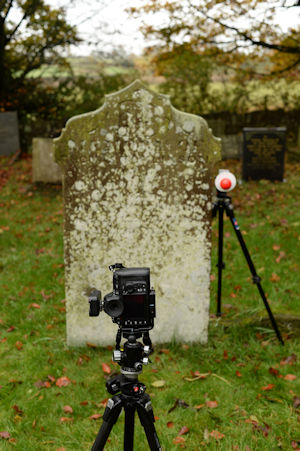
Nonetheless, this can be difficult to do in some settings. At Maeshowe, we found that inscriptions that were close to a corner or higher than two metres were harder to record, although useable results were still achieved. In order to mount the sphere to a tripod, we used a black snooker ball, drilled with a standard 1/4 inch 20 UNC thread so that it be compatible with most camera equipment. We purchased a studio umbrella tripod clamp and used this to connect the ball to the tripod (Figure 9).
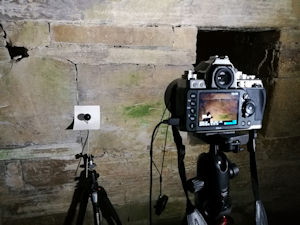
In addition to this, we used a monopod with the flash attached to it to create a flexible, movable light-source. In order that the flash lit the surface of the inscriptions in time with the camera, we used a wireless flash trigger in combination with a wireless remote. Experimentation in the space demonstrated that this set-up was not optimum as the confined space within which we were working did not allow for easy triggering of the camera using a remote that required a line of sight with the camera sensor. We transferred to use of a continuous light-source (an LED light bar) and a wired trigger for the camera. This led to quicker recording and also meant that one team member could watch the camera screen for each image to ensure quality control as the images were created (Figure 10).
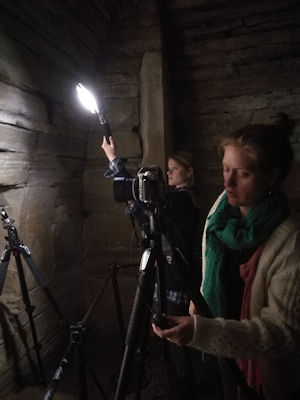
We experimented using a cabled camera, triggered by software on the laptop (See DigiCamControl, but this slowed the process again and for some inscriptions space was insufficient to use the laptop whilst connected to the camera.
By means of a desk-based assessment of the Maeshowe carvings, several research questions were identified:
| Research question 1: Can RTI enable further reading of those parts that cannot be viewed by the eye or camera alone? | Nr.8: could not be completely transliterated due to areas of abrasion |
| Nr.12: very faint, leading to hesitant transliteration | |
| Research question 2: Can RTI detect which runes overlay earlier ones? | Nr.4: features deep pits (either division marks or unrelated to inscription) and shows possible superimposed carvings that might amend an underlying inscription |
| Nr.11: may have been re-scratched in parts | |
| Research question 3: What can RTI reveal about the carving method applied here? | Nr.19: carved in "fits and starts" rather than long lines |
| Research question 4: Can RTI detect any undiscovered traces of carvings surrounding the imagery, other than the "various short lines and scratches" noted by Barnes (1994, 218)? | Nr.XXXII: Lower and upper half ('dragon', 'walrus', and 'knot') |
Inscriptions 8, 12, 13 were recorded.
Nr 8 is a longer collection of runes running across two blocks of stone. We recorded an RTI of the centre of the rune. Nr 8 has sections that Barnes describes as deteriorated (Barnes 1994, 85). Barnes suggests that the deterioration could be due to the surface being deliberately defaced, but comments that there is no visible evidence of this.
Applying specular enhancement to Nr.8 does provide some insight into the difficult to see runes at the beginning of the inscription. Barnes describes the first few runes as an "illegible beginning" (Barnes 1994, 87). We recorded a few centimetres to the left of the first identifiable rune, but there was no additional information to be seen. Although the runes before rune (r.) 1 are still unclear, it is hoped that the image below illustrates that the RTI could augment existing interpretation.
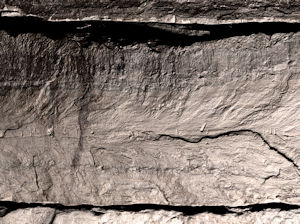
In the image above, r.1 begins at the left-hand edge of the image. There seems to be a clear set of beginning tool marks running along the horizontal centre of the image. This is not noted by Barnes in his publication of findings, but was presumably noticed. In the later runes of Nr.8, Barnes comments that the marks in the centre of the runes are most likely to be natural, but when comparing the RTI results for these later runes (r.61–65; see below) it could be that these are in fact tool marks that are from the same hand as the earlier symbols, where the tool has been re-placed onto the stone halfway up each rune. This could be due to the natural convex shape of the stone in each case.
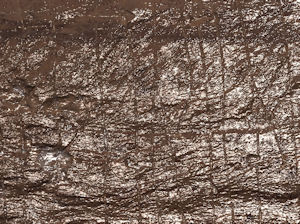
Barnes (1994, 107) comments that in the case of inscription Nr.12, the parallel lines cut through the characters. It seems instead from the RTI that the runes cut through the parallel lines; that they were carved before the runes.
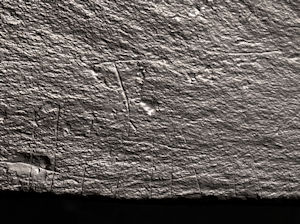
Inscriptions 4, 11 were recorded.
The RTI results for Nr.4 showed clear superimposition, which could aid interpretation. Rune 24 (an 'r' / ᚱ on its side, reading right to left rather than left to right) is shown below.
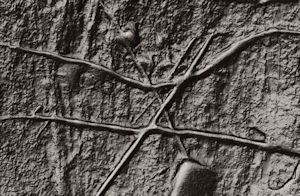
For this example, from initial study the order of inscribed lines for r.24 appears to be as follows:
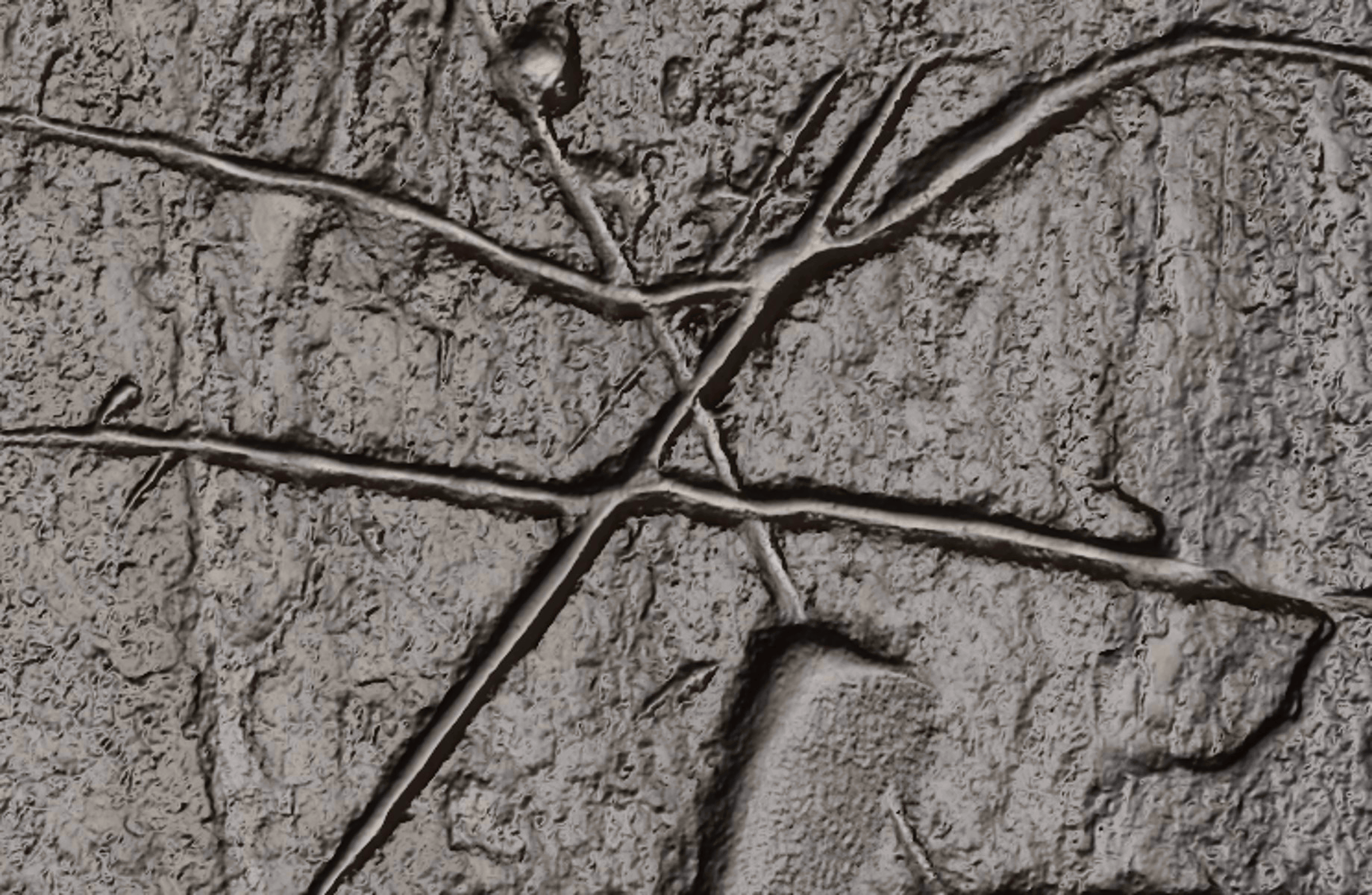
This supports Barnes' interpretation of inscription 4, of lines 1–3, as illustrated in Figure 15, being one phase of inscription and 4 being the second phase of inscription (Barnes 1994, 74, fig. 2). However, Barnes seems to suggest that lines 1–3 are "defacement" (1994, 74: "The attempt to deface rr.20–29 has not been wholly successful"), whereas the RTI seems to point to their being under, rather that over the later 'r' or ᚱ.
We focused on understanding more about the "deep pits" (Barnes 1994, 72: "There are obvious division marks between most of the words… They are clearest at the beginning, consisting of deep, round holes that look as though they were hammered in…") shown below:
The RTI results indicate that the three pits seem to be very similar in size, shape and depth:

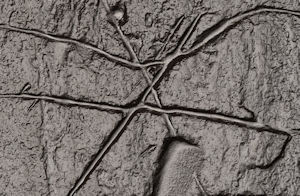
With inscription Nr.11, Barnes writes that "the branch or branches of r2 (if that is what they are) are very weak" (1994, 106). The branches of r.8 become quite clearly visible in this RTI and appear to have been carved with reference to the central line, a slight thickening of the branches approaching the intersection may be as a result of flaking caused by the weakness of stone at the join. Dots at the base of r.4 and r.7 are also clearly visible in the image below (Figure 18).

Inscription 19 was recorded.
In this RTI of Nr.19 (see Figure 19), it is possible to see where the tool has slipped while carving the first rune in the sequence. The nature of these scratches seems to suggest that the runes were carved from the top to the bottom as suggested by Barnes (1994, 139).
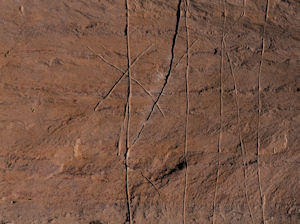
The still from RTI: Mhw16-010_insc_19, in Figure 20 shows a detail from Nr.19 that demonstrates the intersection between r.6 and two diagonal lines between rr.6–7. The intended purpose of these lines is unclear but it is quite clearly visible that r.6 overcuts these earlier lines. This supports Barnes' suggestion that these lines are likely to be earlier than the runic inscriptions and that they do not represent a later attempt to deface the runes (1994, 140).
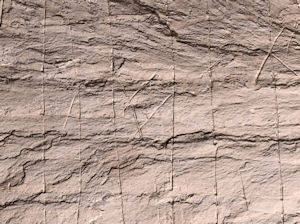
In Figure 21, r.13 of Nr.19 can be seen. It has been tentatively identified as being a dotted 'e' / ᛂ (Barnes 1994, 141). The RTI shows that the small central dot has been cut after the original line and traces of the original line are still visible in the centre of the circle. This supports Barnes' interpretation and shows clearly that the dot was an intentional addition. The uneven and downward direction of carving is visible close to the top of the vertical of this rune, at the base of r.12 and the top of r.14.
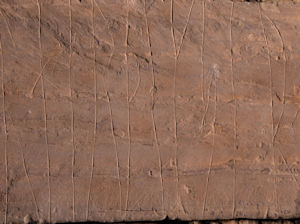
Inscription XXXII ('dragon/lion', 'walrus/seal', 'knot') was recorded.
Barnes comments that there is an uncertain relationship between the interconnecting lines at the top of the 'walrus' carving, Nr.XXXII (1994, 218). The RTI below seems to show that there is no line present at the 'mouth' of the animal, whereas it is visible to the left and the right of the mouth. This makes it difficult to see the relationship between the walrus and the four lines, but the results indicate that there is no intersecting portion of the line, see Figure 22 below.
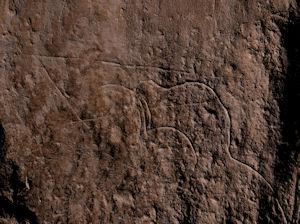
Barnes comments that the carvings have "various short lines and scratches" (1994, 218) above and below them, these are illustrated in Figure 23 of the 'knot' carving.

Additional analysis of the lion or dragon carving might be undertaken, particularly around the head and mouth of the figure to ascertain the relationship between faintly carved lines in this area. It is possible that the figure holds something in its jaws but further investigation is required. It is possible that empirical analysis of the RTI data may reveal further details invisible to the naked eye, see Figure 24.
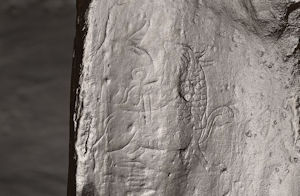
In summary we have demonstrated the value of RTI in studying runic inscriptions and, where multiple inscriptions overlap, in illuminating the sequence of carvings. The approach could also be applied to free-standing runestones, as well as on individual artefacts bearing runic inscriptions. The deposited dataset is made available here for further study by runic scholars. Inscription 15 was captured but was not appropriate in scale to be used in the analysis presented here. It does however appear in the archive.
The data published here have considerable re-use potential for anybody wishing to study or illustrate research conducted on the runic and figurative inscriptions at Maeshowe. In addition to conventional forms of interpretation which have been undertaken using RTI, the data have considerable potential for reuse for empirical analysis. It is quite possible that formal analysis of the RTI outputs using computer vision techniques or statistical analysis may be able to: (a) reveal features which have not been discovered or (b) extract information relating to the characterisation of tool marks or carving styles (Mudge et al. 2010).
Barnes, M.P. 1994 The Runic Inscriptions of Maeshowe, Orkney, Institutionen för Nordiska språk Uppsala Universitet, Uppsala.
Beale, G. and Beale, N. 2015 'Community-driven approaches to open source archaeological imaging' in A. Wilson and B. Edwards (eds) Open Source Archaeology: Ethics and Practice, Berlin: De Gruyter Open. 44-63. https://doi.org/10.1515/9783110440171-005
Challands, A., Muir, T. and Richards, C. 2005 'The Great Passage Grave of Maeshowe' in Richards, C. (ed) Dwelling among the monuments, McDonald Institute Monographies, Cambridge. 229–248.
Davidson, J.L. and Henshall, A.S. 1989 The chambered cairns of Orkney: An inventory of the structures and their contents, Edinburgh: Edinburgh University Press.
Dhoop, T., Cooper, C. and Copeland, P. 2016 'Recording and Analysis of Ship Graffiti in St Thomas' Church and Blackfriars Barn Undercroft in Winchelsea, East Sussex, UK', The International Journal of Nautical Archaeology, 45(2), 296–309. https://doi.org/10.1111/1095-9270.12179
DiBiasie Sammons, J.F. 2018 'Application of Reflectance Transformation Imaging (RTI) to the study of ancient graffiti from Herculaneum, Italy', Journal of Archaeological Science, Reports 17, 184–194. https://doi.org/10.1016/j.jasrep.2017.08.011
Duffy, S., Bryan, P., Earl, G., Beale, G., Pagi H. and Kotoula, E. 2013 Multi-Light Imaging for Heritage Applications, London: English Heritage
Farrer, J. 1862 Notice of runic inscriptions discovered during recent excavations in the Orkneys, Printed for private circulation.
Henshall, A.S. 1963 The chambered tombs of Scotland, Volume One, Edinburgh: Edinburgh University Press.
Jones, J. and Smith, N. 2017 'The Strange Case of Dame Mary May's tomb: The performative value of Reflectance Transformation Imaging and its use in deciphering the visual and biographical evidence of a late 17th-century portrait effigy', Internet Archaeology 44 https://doi.org/10.11141/ia.44.9
Kleintz, C. 2014 'The graffiti of Musawwarat es-Sufra: current research on historic inscriptions, images and markings', Sudan & Nubia: The Sudan Archaeological Research Society, 18: 93–103
Malzbender, T., Gelb, D. and Wolters, H. 2001 'Polynomial texture maps' in J. Pocock (ed) SIGGRAPH '01 Proceedings of the 28th International Conference on Computer Graphics and Interactive Techniques, Los Angeles, CA, 12–17 August 2001, New York: ACM. https://doi.org/10.1145/383259.383320
Mudge, M., Schroer, C., Earl, G., Martinez, K., Pagi, H., Toler-Franklin, C., Rusinkiewicz, S. 2010 Principles and Practices of Robust, Photography-Based Digital Imaging Techniques for Museums, The Eurographics Association.
Mudge, M., Schroer, C., Noble, T., Matthews, N., Rusinkiewicz, S. and Toler-Franklin, C. 2011 'Robust and scientifically reliable rock art documentation from digital photographs' in J. McDonald and P. Veth (eds) A Companion to Rock Art, Hoboken: Wiley-Blackwell. 680–95.
Renfrew, C. 1979 Investigations on Orkney, London.
Riris, P. and Corteletti, R. 2015 'A New Record of Pre-Columbian Engravings in Urubici (SC), Brazil using Polynomial Texture Mapping', Internet Archaeology 38. https://doi.org/10.11141/ia.38.7
Scholma-Mason, N.M.A. 2017 Archaeology and Folklore: The Norse in Orkney's Prehistoric Landscape, PhD thesis, The University of York.
Smith, N., Scholma-Mason, N., Richards, J.D. and Beale, G. 2018 Maeshowe: The Application of RTI to Norse Runes [data-set]. York: Archaeology Data Service [distributor] https://doi.org/10.5284/1050103
Thomas, A. 2016 Art and Architecture in Neolithic Orkney: Process, Temporality and Context, Archaeopress.
Thomas F.W.L. 1852, 'Account of some of the Celtic Antiquities of Orkney, including the Stones of Stenness, Tumuli, Picts-houses, etc., with Plans, by F. W. L. THOMAS, R.N., Corr. Mem. S.A. Scot., Lieutenant Commanding H.M. Surveying Vessel Woodlark', Archaeologia 34: Or, Miscellaneous Tracts, &c., 88–136.
With thanks to Kirsty Owen, Cultural Resources Advisor, Historic Environment Scotland and Alan Jones, Manager - Maeshowe, Historic Environment Scotland who kindly organised out-of-hours access to the chamber at Maeshowe and to the staff and volunteers at Maeshowe who spent time with us in the chamber whilst recording took place. Nicole and Gareth would also like to extend a heartfelt thank-you to Tim Barthorpe and Jenny Barthorpe who very kindly offered lodgings and feasting fit for a king during the fieldwork. Thank you to Yuxi Xie who helped prepare the article for publication.
The research underlying this paper was funded by a priming grant from the Centre for Digital Heritage at the University of York. The costs of publication have been covered by the Department of Archaeology.
Archaeology Institute, University of the Highlands and Islands
Cite this as: Thomas, A. 2018 'Referee Statement' in Smith. N. et al. 2018 Maeshowe: The Application of RTI to Norse Runes (Data Paper), Internet Archaeology 47. https://doi.org/10.11141/ia.47.8
The chambered tomb of Maeshowe, Orkney, is one of the best-preserved and well-built prehistoric buildings in northern Europe. It is remarkable not only for the quality of its Neolithic architecture, but also the extensive collection of Norse runic inscriptions on its walls, considered by many to be the finest outwith Scandinavia. Since their discovery in the 1860s, these have been much debated, but they have generally only been studied linguistically rather than in terms of their physical composition. One particular issue with the carvings is where they appear to overlie other markings, many of which have been interpreted as Neolithic.
In applying RTI to recording some of these inscriptions, the authors of this paper make a considered and very welcome attempt to not only pick apart some of these sequences but also consider the materiality of the carvings. For example, RTI images of part of Nr.4 show that a series of additional intersecting lines interpreted by Barnes as an attempt to deface the runes (Barnes 1994, 71–75) actually underlie rather than overlie the runic carving. Similarly, the lines underlying the carving of the walrus on the southwest edge of the orthostat in the eastern buttress are confirmed by the RTI results as unrelated to, and underlying, the walrus. Although these sequences have previously been discussed by other researchers (Ashmore 1986; Bradley et al. 2000; Thomas 2016, Chapter 3), the RTI images are useful in confirming, and providing clear photographic illustrations of, these interpretations.
This is a useful data set which can be used as a springboard for future work. It would be good to apply this technique to other areas within the tomb, particularly where there are complex sequences of inscriptions. In making their RTI data available online, the authors have allowed their work to be used and interpreted by a range of researchers. It will be useful not only to scholars of Norse history and runic inscriptions, and those researching markings of other dates within Maeshowe, but also those with a broader interest in the application of survey techniques to record stone-carving and inscriptions.
Ashmore, P.J. 1986 'Neolithic carvings in Maes Howe', Proceedings of the Society of Antiquaries of Scotland, 116, 57–62.
Barnes, M.P. 1994 The Runic Inscriptions of Maeshowe, Orkney, Institutionen för Nordiska språk Uppsala Universitet, Uppsala.
Bradley, R., Phillips, T., Richards, C. and Webb, M. 2000 'Decorating the Houses of the Dead: Incised and pecked Motifs in Orkney Chambered Tombs', Cambridge Archaeological Journal, 11(1), 45–67.
Thomas, A. 2016 Art and Architecture in Neolithic Orkney: Process, Temporality and Context, Archaeopress.
Internet Archaeology content is preserved for the long term with the Archaeology Data Service. Help sustain and support open access publication by donating to our Open Access Archaeology Fund.
Internet Archaeology is an open access journal based in the Department of Archaeology, University of York. Except where otherwise noted, content from this work may be used under the terms of the Creative Commons Attribution 3.0 (CC BY) Unported licence, which permits unrestricted use, distribution, and reproduction in any medium, provided that attribution to the author(s), the title of the work, the Internet Archaeology journal and the relevant URL/DOI are given.
Terms and Conditions | Legal Statements | Privacy Policy | Cookies Policy | Citing Internet Archaeology
Internet Archaeology content is preserved for the long term with the Archaeology Data Service. Help sustain and support open access publication by donating to our Open Access Archaeology Fund.